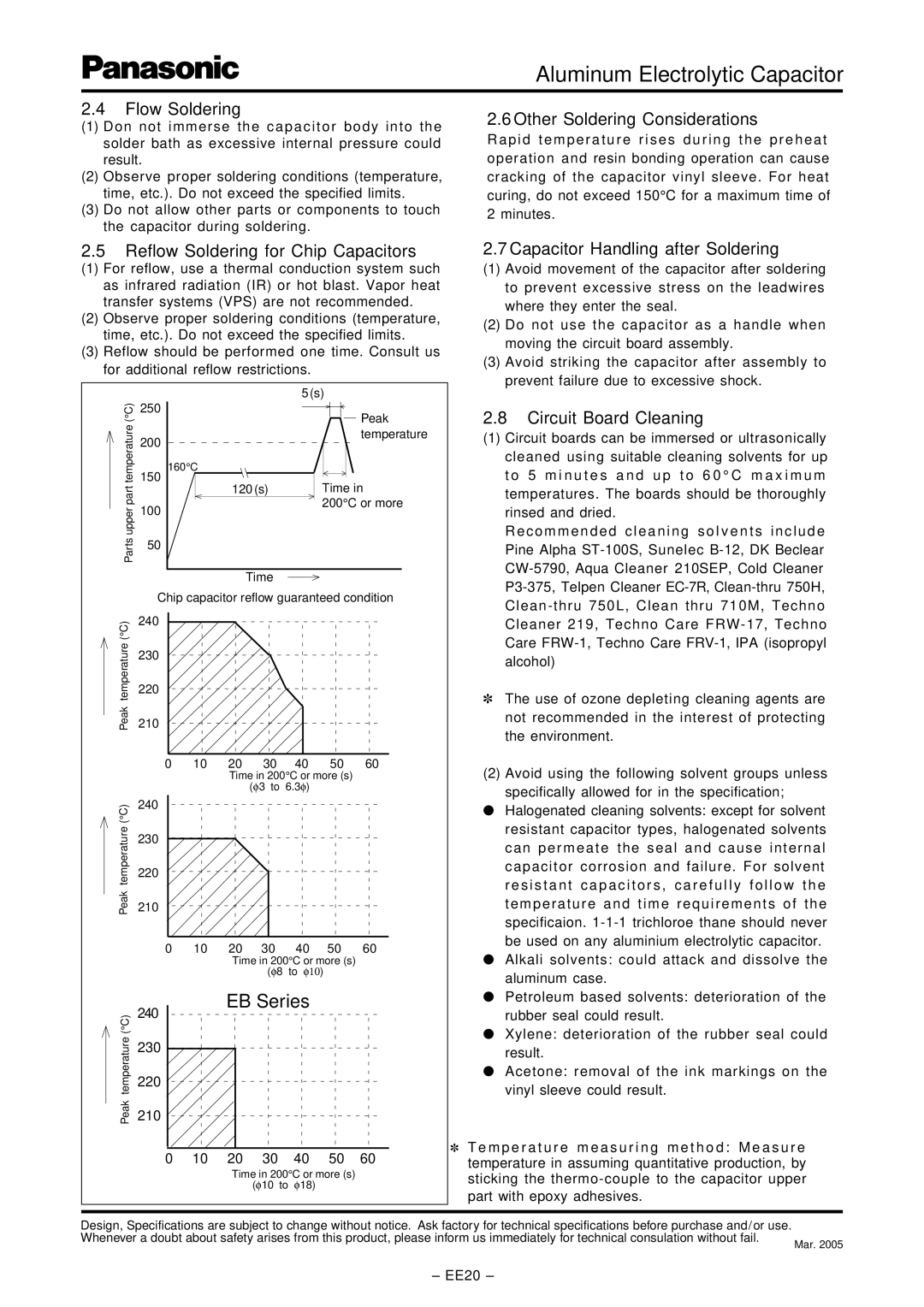
Aluminum Electrolytic Capacitor
2.4Flow Soldering
(1)Don not immerse the capacitor body into the solder bath as excessive internal pressure could result.
(2)Observe proper soldering conditions (temperature, time, etc.). Do not exceed the specified limits.
(3)Do not allow other parts or components to touch the capacitor during soldering.
2.6 Other Soldering Considerations
Rapid temperature rises during the preheat operation and resin bonding operation can cause cracking of the capacitor vinyl sleeve. For heat curing, do not exceed 150°C for a maximum time of 2 minutes.
2.5Reflow Soldering for Chip Capacitors
(1)For reflow, use a thermal conduction system such as infrared radiation (IR) or hot blast. Vapor heat transfer systems (VPS) are not recommended.
(2)Observe proper soldering conditions (temperature, time, etc.). Do not exceed the specified limits.
(3)Reflow should be performed one time. Consult us for additional reflow restrictions.
|
| 5(s) | |
(°C) | 250 | Peak | |
| |||
temperature |
| ||
200 | temperature | ||
| |||
160°C |
| ||
150 | Time in | ||
part | 120(s) | ||
100 | 200°C or more | ||
upper | |||
| |||
|
| ||
Parts | 50 |
| |
|
|
|
|
|
| Time |
|
|
|
| Chip capacitor reflow guaranteed condition | ||||||
(°C) | 240 |
|
|
|
|
|
|
|
|
|
|
|
|
| |
temperature | 230 |
|
|
|
|
|
|
220 |
|
|
|
|
|
| |
|
|
|
|
|
|
| |
Peak | 210 |
|
|
|
|
|
|
| 0 | 10 | 20 | 30 | 40 | 50 | 60 |
|
|
| Time in 200°C or more (s) |
| |||
|
|
|
| (φ3 to 6.3φ) |
|
| |
(°C) | 240 |
|
|
|
|
|
|
|
|
|
|
|
|
| |
temperature | 230 |
|
|
|
|
|
|
220 |
|
|
|
|
|
| |
|
|
|
|
|
|
| |
Peak | 210 |
|
|
|
|
|
|
| 0 | 10 | 20 | 30 | 40 | 50 | 60 |
|
|
| Time in 200°C or more (s) |
| |||
|
|
|
| (φ8 to φ10) |
|
| |
| 240 |
| EB Series |
|
| ||
(°C) |
|
|
|
|
|
| |
|
|
|
|
|
|
| |
temperature | 230 |
|
|
|
|
|
|
220 |
|
|
|
|
|
| |
|
|
|
|
|
|
| |
Peak | 210 |
|
|
|
|
|
|
| 0 | 10 | 20 | 30 | 40 | 50 | 60 |
|
|
| Time in 200°C or more (s) |
| |||
|
|
|
| (φ10 to | φ18) |
|
|
2.7 Capacitor Handling after Soldering
(1)Avoid movement of the capacitor after soldering to prevent excessive stress on the leadwires where they enter the seal.
(2)Do not use the capacitor as a handle when moving the circuit board assembly.
(3)Avoid striking the capacitor after assembly to prevent failure due to excessive shock.
2.8Circuit Board Cleaning
(1)Circuit boards can be immersed or ultrasonically cleaned using suitable cleaning solvents for up
t o 5 m i n u t e s a n d u p t o 6 0 ° C m a x i m u m temperatures. The boards should be thoroughly rinsed and dried.
Recommended cleaning s o l v e n t s include Pine Alpha
✽The use of ozone depleting cleaning agents are not recommended in the interest of protecting the environment.
(2)Avoid using the following solvent groups unless specifically allowed for in the specification;
●Halogenated cleaning solvents: except for solvent
resistant capacitor types, halogenated solvents can permeate the seal and cause internal capacitor corrosion and failure. For solvent r e s i s t a n t c a p a c i t o r s , c a r e f u l l y f o l l o w t h e temperature and time requirements of the specificaion.
●Alkali solvents: could attack and dissolve the aluminum case.
●Petroleum based solvents: deterioration of the rubber seal could result.
●Xylene: deterioration of the rubber seal could result.
●Acetone: removal of the ink markings on the vinyl sleeve could result.
✽ T e m p e r a t u r e m e a s u r i n g m e t h o d : M e a s u r e temperature in assuming quantitative production, by sticking the
Design, Specifications are subject to change without notice. Ask factory for technical specifications before purchase and/or use. Whenever a doubt about safety arises from this product, please inform us immediately for technical consulation without fail.
– EE20 –
Mar. 2005
